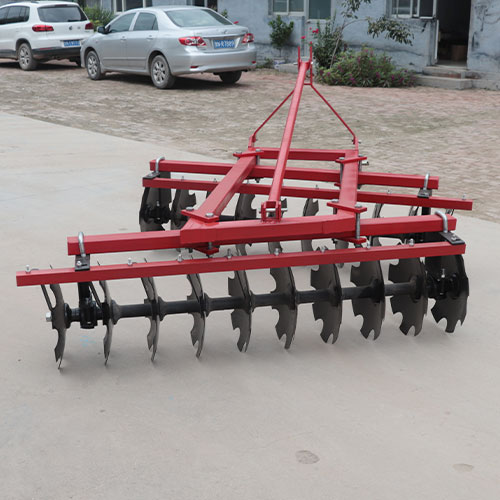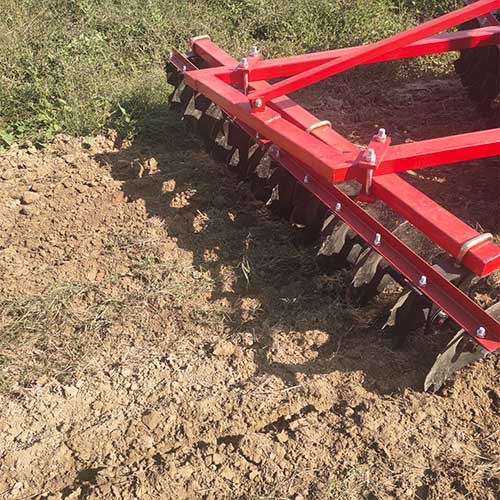Introduction
Disc for harrows are widely recognized for their ability to prepare seedbeds, aerate soil, and control weeds. They are a staple in no-till farming and are used across the globe for a variety of soil conditions and farming needs. Understanding the intricacies of disc harrows is crucial for farmers looking to optimize their operations.
Types of Disc for Harrows

Several types of disc harrows are available, each with specific applications and advantages:
Offset Disc Harrows: Designed to work around existing crops or obstacles, providing flexibility in use.
Heavy Duty Disc Harrows: Built for breaking up compacted soil and for use in heavy-duty applications.
Light Duty Disc Harrows: Suitable for lighter soil conditions and for finishing tasks.
Mid Mount Disc Harrows: Attached to the mid-point of the tractor, offering better weight distribution and maneuverability.
Tandem Disc Harrows: Equipped with two sets of discs, they provide a wider coverage and deeper tillage.
Table: Comparison of Disc for Harrow Types
| Feature/Type | Offset | Heavy Duty | Light Duty | Mid Mount | Tandem |
|---|---|---|---|---|---|
| Soil Condition | Various | Compacted | Light | Various | Various |
| Application | General | Deep Tillage | Finishing | Precision | Wide Coverage |
| Weight | Light | Heavy | Light | Medium | Heavy |
| Maneuverability | High | Low | High | High | Low |
| Suitability | Around crops | Heavy-duty tillage | Light tillage | Precision tasks | Wide area coverage |
Factors to Consider When Choosing a Disc for Harrow
Selecting the appropriate disc harrow involves several considerations:
Soil Type: The selection of the appropriate disc harrow is heavily influenced by the characteristics of the soil you’re operating in. Different soil types require specific disc types and configurations to ensure optimal performance and efficiency in tillage operations.
Tillage Depth: Various types of disc harrows are engineered with specific tillage depths in mind. Tailoring the choice of disc harrow to the desired tillage depth ensures effective soil preparation and cultivation for different agricultural applications and crop requirements.
Tractor Compatibility: It’s crucial to verify that the disc harrow is compatible with your tractor’s horsepower rating and hitch type. Ensuring compatibility between the tractor and disc harrow guarantees optimal performance, safety, and efficiency during field operations, minimizing potential issues and maximizing productivity.
Size of Operation: The scale of your farming operation plays a pivotal role in determining the required width and weight of the disc harrow. Matching the size of the disc harrow to the extent of the farming operation ensures efficient coverage and effective soil tillage, optimizing productivity and performance in agricultural activities.
Budget: When selecting a disc harrow, it’s essential to factor in both the initial cost and its long-term value to your farming operation. Evaluating the upfront investment alongside potential benefits such as durability, efficiency, and productivity helps make informed decisions that align with your budget and contribute to sustainable farming practices.
Benefits of Using Disc for Harrows
Disc harrows offer numerous benefits to farmers:
- Improved Soil Structure: They help in breaking up compacted soil, improving aeration and water infiltration.
- Efficient Weed Control: Disc harrows can effectively bury weeds, reducing their impact on crops.
- Conservation Tillage: They support no-till or conservation tillage practices, which are beneficial for soil health.
- Time and Labor Savings: Disc harrows can reduce the time and labor required for soil preparation.
- Cost-Effectiveness: Over time, the use of disc harrows can lead to cost savings through improved yields and reduced labor.
Optimizing Disc for Harrow Efficiency

To get the most out of your disc for Harrow, consider the following tips:
- Proper Maintenance: Regularly check and maintain your disc harrow to ensure it operates at peak efficiency.
- Correct Spacing: The spacing between discs can affect the level of soil disturbance and weed control.
- Appropriate Speed: The speed at which you operate the disc harrow can impact the quality of tillage.
- Seasonal Adjustments: Adjust your disc harrow’s settings based on the season and the specific needs of your crops.
Conclusion
Disc for Harrows are powerful tools that, when chosen and used correctly, can greatly enhance farm efficiency. By considering factors such as soil type, tillage depth, tractor compatibility, operation size, and budget, farmers can select the right disc harrow for their needs. With proper use and maintenance, disc for Harrows can lead to improved soil health, efficient weed control, and ultimately, better crop yields.
FAQ
What is the primary function of a disc harrow?
- The primary function of a disc harrow is to break up soil, eliminate weeds, and incorporate crop residues.
How do disc harrows differ from other tillage tools?
- Disc harrows differ from other tillage tools in their ability to provide a high level of soil disturbance in a single pass, their versatility in soil conditions, and their ability to work in and around existing crops.
How often should disc harrows be maintained?
- Disc harrows should be maintained before and after each use, with more thorough inspections and maintenance performed periodically throughout the year.
Can disc harrows be used in conservation tillage practices?
- Yes, disc harrows are often used in conservation tillage practices due to their ability to minimize soil disturbance and maintain soil structure.
What is the impact of disc harrows on soil health?
- Proper use of disc harrows can lead to improved soil health by breaking up compaction, enhancing aeration, and incorporating organic matter.

